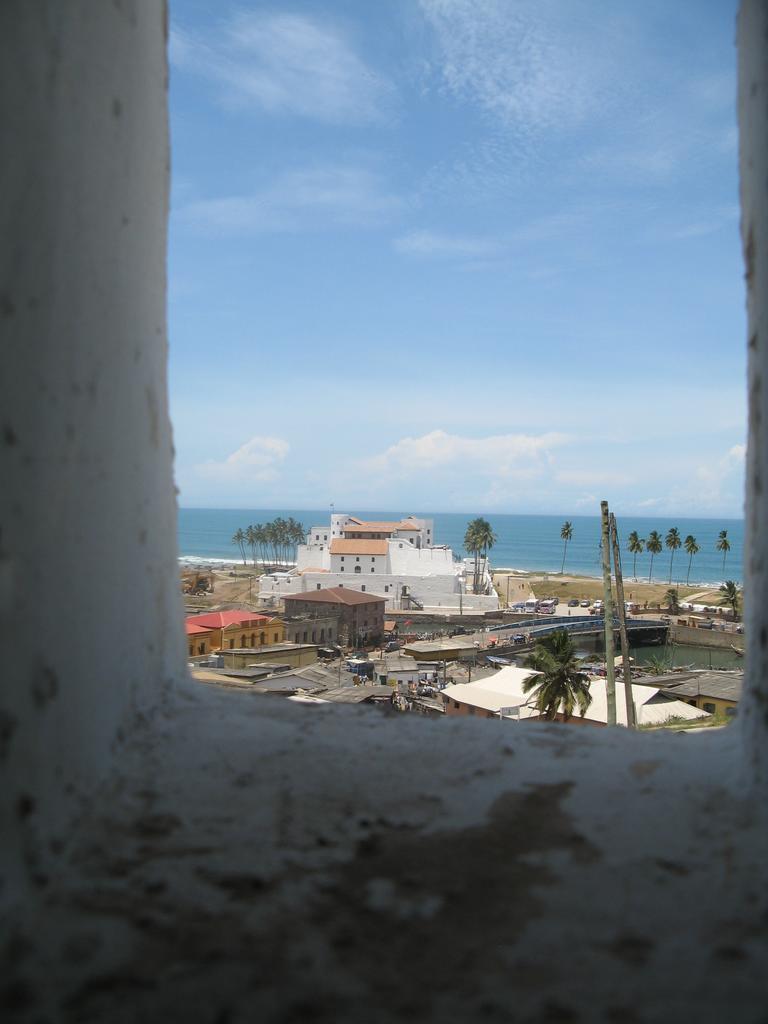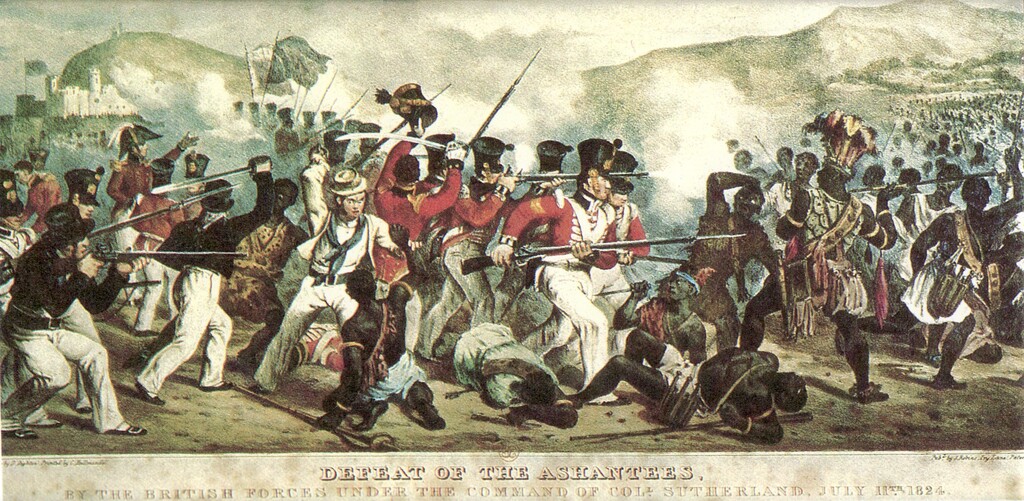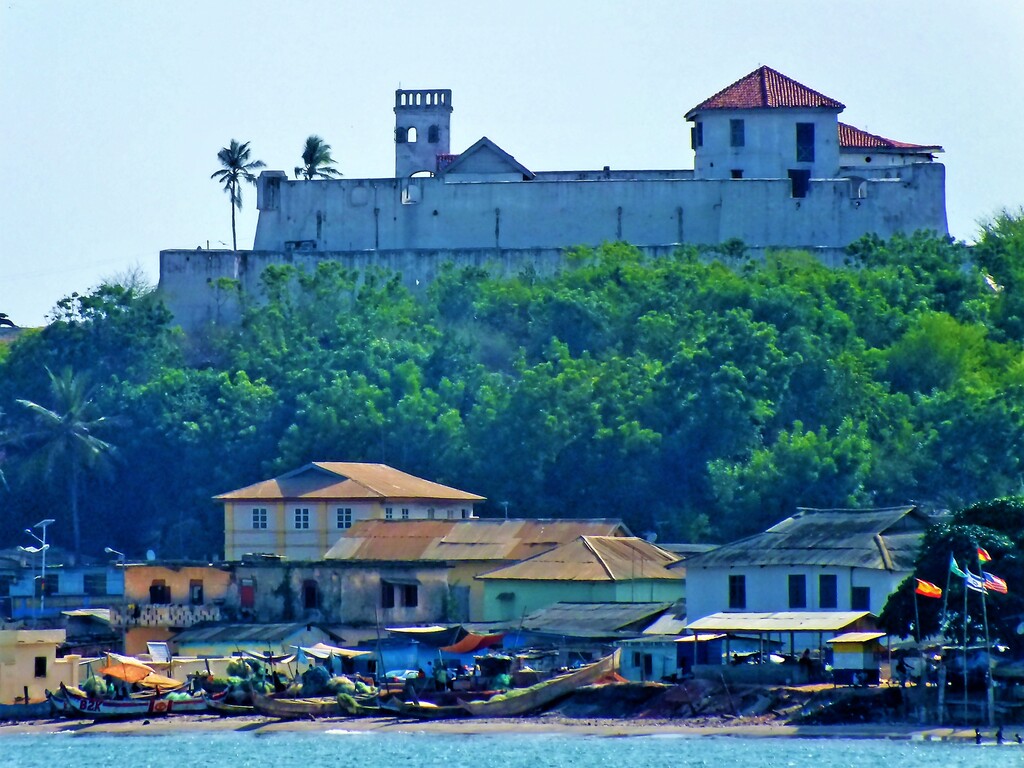
(c) Remo Kurka / Elmina Castle, as seen from Upper (Dutch) Fort St Jago
In the mid-1800s, West Africa was rapidly changing—and not for the better. Foreign flags flew over the coastline. Gold, palm oil, and human lives were sold under the watch of European cannons. Forts that once served as gateways for trade had become symbols of foreign control. But for the Ashanti Empire, still powerful, still proud, the struggle was not over. The Ashanti were determined not just to resist colonial domination—but to preserve their independence at any cost.
Advertisement

Battle between British and Ashanti 1824. The first Ashanti-British war, and the British lost.
By the 1860s, the Ashanti were not strangers to war, diplomacy, or trade. From their capital at Kumasi, they ruled over a vast and organized empire with structured governance, a professional army, and a long tradition of diplomacy—both African and European. They were traders of gold, kola, slaves, and cloth, but they were also a sovereign kingdom, never fully conquered, never fully tamed.
For decades, the Ashanti had maintained a delicate alliance with the Dutch, whose fortress at Elmina Castle was the empire’s most crucial outlet to the coast. Through Elmina, the Ashanti received firearms, luxury goods, and communication with the outside world. More importantly, it was through Elmina that they maintained their economic independence and military strength.

Fort St Jago, Dutch build fort, to protect Elmina Castle. (c) Remo Kurka
In 1867, without so much as a conversation with the Ashanti court, the British and Dutch signed the Anglo-Dutch Gold Coast Treaty. Under this agreement, all forts east of Elmina were handed to the British. The Dutch were to take over forts to the west. It was a colonial handshake—a neat division of spheres—but to the Ashanti, it was a betrayal.
And worse was to come.
The Dutch struggled to enforce their new claims. In places like Komenda, coastal people refused Dutch authority. Meanwhile, the Fante Confederacy—longtime rivals of the Ashanti and backed by British guns and gold—were gaining power. They isolated Elmina, harassed Dutch positions, and threatened to cut the Ashanti off completely from the coast. Suddenly, Elmina was under siege, not just physically, but diplomatically.
The Dutch, under pressure at home and in Africa, did not resist for long. In 1871, they sold Elmina and all their remaining possessions to Britain. The Ashanti had been sold out.
The Ashanti saw the writing on the wall. With Elmina gone, Britain now controlled nearly the entire Gold Coast. The British had no interest in preserving Ashanti sovereignty—they had repeatedly supported the Fante and other coastal states that opposed the empire. This wasn’t just about a fort. It was about the future of the kingdom itself.
Elmina was the Ashanti’s lungs, their breath to the outside world. Without it, they would be strangled—economically, politically, militarily. With British hands tightening around the coast, the Ashanti understood what was coming: taxation without trade, peace without partnership, submission disguised as diplomacy.
King Kofi Karikari, successor to the formidable Osei Bonsu, watched as the empire’s lifelines were threatened. He, like his predecessors, would not accept humiliation lightly.

View from Elmina Castle to the Upper Dutch Fort.
When Britain officially raised its flag over Elmina in 1872, the Ashanti responded. They marched south, not merely to reclaim a castle, but to send a message: We are not your subjects. We are your equals.
This escalation led to the Third Anglo-Ashanti War (1873–1874). Thousands of Ashanti soldiers, armed with muskets and courage, clashed with the British Expeditionary Force. Despite the British having superior firepower, the Ashanti fought fiercely. At times, they even defeated their enemies in skirmishes, relying on mobility, knowledge of terrain, and sheer determination.
British troops described the Ashanti army as “disciplined, fearless, and highly coordinated.” They were no scattered tribal force—they were an army forged in a century of war, unified under a sacred stool, and led by kings who ruled by divine right.
But even courage has its limits. After a grueling campaign, the British reached Kumasi, and although they couldn’t hold the city, they burned it. The Ashanti were forced to sue for peace in 1874. The British demanded indemnities and a declaration that Ashanti influence over the southern coast was permanently ended.
The Ashanti may have lost the war, but they never fully surrendered. They rebuilt. They reorganized. They resisted again in 1895, in what would be the final Anglo-Ashanti War. Even after being defeated and annexed in 1901, they never gave up their identity. Their traditional leadership—the Asantehene and the Golden Stool—remained symbols of sovereignty and pride. The British never dared to sit on the Stool; it was not just a throne—it was a soul.
In the 20th century, the Ashanti would play a crucial role in the fight for Ghana’s independence. And today, Asanteman still exists, recognized as a kingdom within a republic—a living legacy of resistance against empire.
The Anglo-Dutch Treaty of 1867 wasn’t just a bureaucratic reshuffling of European possessions—it was a turning point. It exposed the fragility of African-European alliances, and it revealed how Africa’s destiny was being written in ink that never dried.
The Ashanti fought not to conquer, but to preserve.
Not to enslave, but to survive.
Not as pawns of empire—but as kings of their own land.